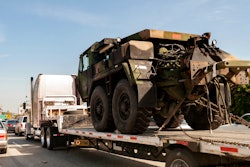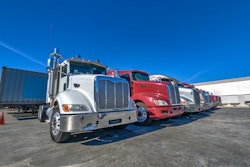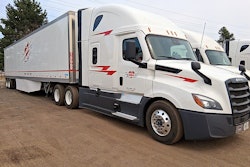Prophesy Transportation Software (www.mile.com) released its new Document Imaging & Rendition Billing module for its Dispatch Series software. The new option allows users to quickly scan and index all trucking-related paperwork on a trip-by-trip basis. Images can be viewed, printed, e-mailed or faxed with a simple mouse click.
WebTech Wireless (www.webtech.com), a provider of location-based and fleet telematics services, said that Rogers Communications, Canada’s largest wireless voice and data communications services provider, signed an exclusive supply agreement to sell WebTech’s Quadrant system under the mFleet brand.
Innovative Computing Corp. (www.innovativecomputingcorp.com) said the latest version of its flagship product, Innovative Enterprise Software (IES R8V02), contains more than 75 enhancements to many of its modules.
TMW Systems (www.tmwsystems.com) said that March usage of electronic data interchange (EDI) by TMW customers rose a record 23 percent over the same period last year. The surge demonstrates increasing demand by shippers to do business with their carriers electronically, says David Wangler, president and CEO.
ALK Technologies (www.pcmiler.com) said TMW Systems has integrated ALK’s Multi-Version Switch (MVS) with its TMWSuite software, allowing carriers to integrate and access multiple PC*Miler versions on the same server.
With 165 trucks, GEM Plumbing and Heating (www.gemplumbing.com) is the largest commercial and residential service fleet of its kind in Rhode Island, and one of the largest in the nation. It also appears to be one of the most efficient.
Operating costs for the Lincoln, R.I.-based fleet are 5.2 percent of gross sales. By comparison, most service fleets operate at 5.9 to 6.3 percent, says Larry Gemma, executive vice president.
“We measure everything,” Gemma says. “There are numbers we measure that people say can’t be measured. It is amazing how much you can bring the numbers down when you focus on something. Every dollar saved is 100 percent profit.”
GEM’s achievement in fuel savings is a case in point. In the past five years, the company says it has reined in its fuel costs through utilizing a full spectrum of information technology.
About five years ago, when the company was operating 80 vehicles, management used its Dossier 32 fleet maintenance software from Arsenault Associates to analyze equipment costs on a per-mile basis. The analysis led management to replace 75 percent of its fleet – even though the economy was down and cash was tight. “It was so much more costly to not buy new vehicles,” Gemma says.
The company also uses its Dossier program to track the mpg of each vehicle by importing mpg data directly from its fuel card program by Wright Express. “We know what each individual truck should get,” Gemma says.
Once on the road, the company uses exception reporting from Wright Express to pinpoint drivers whose mpg falls below established thresholds. At each scheduled oil change, a mechanic also looks at the mpg report within Dossier to determine if a tune-up might be necessary.
The use of a vehicle asset tracking system from @Road also has reduced fuel costs significantly – by about 5 percent, or between $4,000 and $5,000 a month, Gemma says. The GPS tracking system enables dispatchers to route drivers between jobs more efficiently. Drivers also benefit by spending less time driving and more time with customers.
Dispatchers can qualify for an incentive by keeping their routes to 50 miles or less. Drivers earn an incentive for keeping their productive time – their billable time with customers – above 62 percent. By comparison, the industry average for productive time is 50 percent, Gemma says. “The key to driving efficiency is to keep windshield time to a minimum.”
Three years ago, GEM added a new dispatching center to further improve efficiency. A 12-foot screen in the room shows the exact location of all vehicles in real time, as well as fixed highway traffic views. This real-time traffic system helps dispatchers re-route service trucks in the event of traffic tie-ups or inaccessible roadways.
GEM also has leveraged inventory management to reduce fuel costs. The company’s inventory system tracks the weight of supply parts in each vehicle. By using information to fine-tune its inventory carried in trucks, GEM reduced part types (SKUs) from 1,327 to 975, which reduced its payload by 250 pounds per truck. Lighter trucks increased fuel economy from 7.1 to 7.3 mpg, for about 33 gallons a day in savings, Gemma says. “Reducing the load made a huge difference.”
In the next few months, GEM plans to release another information technology tool to fully leverage all of its information to operate even more efficiently: A real-time “dashboard” application allowing each employee to monitor performance relative to budget. On the equipment side, GEM is looking toward hybrid vehicles to gain another leap in fuel efficiency.
To share its best practices and technology innovations with other fleets, the company started an on-site training program called GEM Institute. The program includes a full-day seminar with GEM executives and tours of company facilities to see the fleet’s latest technology, management systems, marketing and culture.
“We charge money for it, but it all goes to breast cancer research,” Gemma says. “It is our way of giving back.”
Qualcomm to provide Maptuit’s NaviGo
Qualcomm and Maptuit have entered into an agreement to make available Maptuit’s NaviGo on Qualcomm’s OmniVision mobile computing platform. Executives at both companies say the solution will be available in early fall 2007. Maptuit’s NaviGo is a real-time, hybrid (a combination of onboard and server-based technologies) in-cab navigation service designed to provide drivers and carriers with interactive maps for increased routing efficiency and improved driver satisfaction. With Maptuit, companies can look up addresses, create maps, perform proximity searches, generate optimized routes and provide directions.
“We are excited to work with Maptuit to make the NaviGo service available to our customers,” says Norm Ellis, vice president and general manager of global transportation and logistics for San Diego-based Qualcomm Wireless Business Solutions.
Qualcomm’s OmniVision mobile computing platform is an integrated system consisting of hardware, software and network infrastructure designed to enable delivery of two-way data communications and value-added services. The OmniVision platform offers text-to-speech capability to allow drivers to listen to and replay messages, eliminating the need to pull over and stop the vehicle to read a text message. The platform also features an integrated color touchscreen and a remote control device, providing drivers quick access to critical information.
GE’s VeriWise offers new sensor, interface
GE’s Asset Intelligence division is offering its patented full-length cargo sensor on the VeriWise satellite platform in addition to its cellular platform, and also has launched the next generation of its VeriWise Web user interface. The VeriWise trailer tracking and monitoring system is available exclusively through GE’s Trailer Fleet Services business (www.trailerservices.com).
The full-length cargo sensor already was integrated into the VeriWise Cellular solution – the former Terion FleetView system – installed on about 40,000 trailers. The sensor can monitor the entire trailer and detect even a single pallet that would render the trailer unavailable for a new load, GE says.
The new Web interface for VeriWise goes beyond user-requested lists of trailers and instead actively identifies problems and ranks trailers, priorities and landmarks in real time based on user-defined criteria, GE says.
REAL-TIME CONTROL
In his keynote address at the third annual ALK Transportation Technology Summit on April 24, Alain Kornhauser shared a vision that is increasingly becoming reality for carriers – a vision he described as “optimal, real-time management and control of mobile assets.”
Kornhauser – a professor of operations research and financial engineering at Princeton University – is also co-founder and board chair of ALK Technologies, which offers the PC* Miler routing, mileage and mapping software application, among others.
Some of the basic building blocks of Kornhauser’s vision already have become commoditized, he said. Devices such as cell phones and onboard computers already “know where they are” via the Global Positioning System (GPS).
“It won’t be too long that every device that has any processing power will know where it is – just like any device knows the time,” Kornhauser said. As GPS and mobile computing have become commodities, so too has navigation with turn-by-turn directions, he said.
What is emerging, however, is the back-and-forth transfer between management servers and mobile assets of real-time information such as traffic patterns and travel times. In addition, multiple partners – shippers and carriers, for example – are beginning to use Web services to gather and share information in real time to synchronize and control assets, he said.
“That’s where the value is in all of this,” Kornhauser said.
The power of integration
One example of this evolution was given by Ken Crane, application manager of mobile technology for U.S. Xpress Enterprises. Crane presented a case study about how the large Chattanooga, Tenn.-based truckload carrier uses in-cab navigation and real-time information to cut costs while improving driver satisfaction.
Last year, management at U.S. Xpress saw that bad data in its dispatch applications -directions, in particular – were causing drivers to waste time searching for customers and fuel stops.
“That has always been a concern, but of late it had become more of a concern,” Crane said. So the company deployed the DriverTech onboard computing platform and uses ALK’s CoPilot turn-by-turn navigation software. U.S. Xpress also worked with a fuel optimization vendor, IDSC, to incorporate optimal routes and fuel information into CoPilot.
“Once you start adopting this technology, you are going to find the holes in your operations pretty quickly,” Crane said. Besides operational cost savings, the company has seen driver retention benefits. “We have had drivers that have pressed us for the new technology.”
Routing and navigation are two of many technologies that are being used to monitor, synchronize and control mobile assets. Dave Mook, chief operations and technology officer of TMW Systems, gave attendees at the ALK Summit his vision of total supply chain visibility – an interconnected world enabled by service-oriented architectures (SOA) such as Web services, XML messaging, EDI and even RFID.
“Everybody wants to know where their box is,” Mook said. “Everybody is dying for visibility.”
Customer communications
One of the shortcomings of transportation management systems used by shippers today is that the load tendering process is based on carrier commitments and not on current capacity information. “It is fairly easy to make systems talk to each other,” Mook said. “As the cost of communications goes down, standards become interconnected.”
Scott Sullivan, vice president of information systems for Pitt Ohio Express, provided some examples of how the Pittsburgh-based LTL carrier provides value to its customers through its use of SOA. Pitt Ohio – CCJ’s latest Innovator of the Year – offers two options for real-time communications with customers. The first is FTP (file transfer protocol) delivery receipts into the customer’s server.
Second, customers have begun using an XML stream via Web services for real-time updates into their system. By customers having integration directly into Pitt Ohio’s system, the carrier can give them the same status that it has, Sullivan says.
Mook said TMW Systems plans to add more intelligence to its products to better manage all the data that is being captured from mobile assets and other sources. Today’s real-time alerts and exception management tools are moving toward systems that automate the necessary workflow when exceptions do occur. The next step is to use predictive intelligence – for example, to know the impact of a late load on a customer, or to predict the turnover risk of a driver that has declining pay, calls in sick two times in last three months, or has five hard-braking incidents. “Adding intelligent pieces is key for TMW and key for carriers,” Mook said.
At the ALK Transportation Technology Summit, attendees also caught a glimpse of a futuristic design for the control of mobile assets. Kornhauser showcased a student-led project – an autonomous computer-driven vehicle – that recently competed in the Defense Advanced Research Projects Agency (DARPA) challenge.
Although it seems unlikely that a computer-driven truck will ever replace a driver on a U.S. highway, the technology discussed at the ALK Summit showcased how fleets can add more value to the work their drivers now provide.










